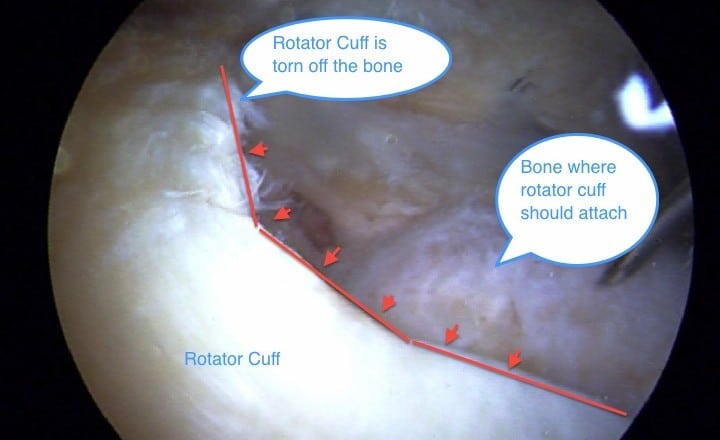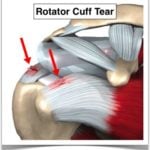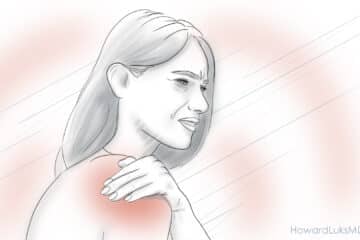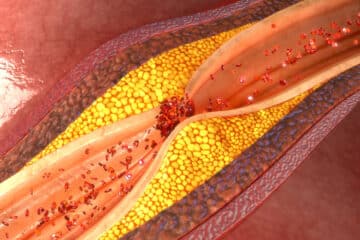
While full thickness rotator cuff tears are very common, let’s back up and start with the basics about these 4 little muscles. The rotator cuff plays a key role in the proper function of the shoulder. The four muscles which make up the “rotator cuff” are under a lot of stress. They need to maintain proper function of the shoulder. If the cuff sees too much stress they can become inflamed, or start to tear. Age or activity related degeneration can also leave our rotator cuff at risk of injury. The rotator cuff can be a source of pain for many many reasons.
Your shoulder pain can be due to:
- inflammation of the rotator cuff
- degeneration (tendinosis) of the rotator cuff
- tears of the rotator cuff.
Tears of the rotator cuff come in all shapes and sizes. Fraying of the rotator cuff tendon surface, partial thickness tears, and full thickness rotator cuff tears are all quite common. Interestingly, the degree of damage seen on the MRI does not predict how severe your pain will be. That means that there are some of you with small rotator cuff tears, or no rotator cuff tear, yet you have severe shoulder pain. On the other hand, there are many people with large full thickness rotator cuff tears who have very little pain. It can be confusing.
How do Orthopedists figure out which type of rotator cuff problem you have and how does that effect our treatment plan for your shoulder pain?
Rotator Cuff Tears:
Before we delve briefly into whether or not you have a full thickness rotator cuff tear (complete tear),you need to know what the rotator cuff is.

The rotator cuff is a series of four muscles, which combine at the shoulder to form a cuff of tissue completely surrounding the top of the arm bone or humerus.
Rotator cuff tears can be described in many different ways.
- There are traumatic tears (accident or a fall), acute tears (just happened)
- Chronic tears (present for a while, you just didn’t know it)
- Degenerative tears ( your tendon just wore out).
Rotator cuff tears can also be described as being partial, or full thickness. With partial thickness rotator cuff tears only part of the tendon has torn off the bone. With full thickness tears the entire tendon has separated or torn from the bone. Click here to learn about partial thickness tears.
Can you tell if you have a full thickness rotator cuff tear?
After a significant trauma such as a fall or a car accident, your rotator cuff tendon can literally pull right off the bone. We call that an acute, traumatic full-thickness rotator cuff tear. On the other hand, I see many patients in the office who do not recall any significant injury, but their exam and MRI demonstrate that they have a full thickness tear — why is that? The risk of developing a rotator cuff tear increases with age because our tendons begin to gradually wear, lose its blood supply and its resilience. In that situation, even routine daily activities like gardening or working around the house increase the potential for wear, degeneration, and tearing.
Whether your tear is chronic, attritional (wear and tear) or acute and traumatic (fall or injury) is a VERY important element of the decision-making process in how we treat full-thickness rotator cuff tears. Treatment decisions are based not only on the type of tear you have, but whether or not other treatments have failed, and how poor your quality of life is.
Rotator cuff tears, whether acute or chronic can cause severe pain. Many of you report temporary relief using:
- A shoulder ice sleeve
- A shoulder compression sleeve
- A Shoulder support pillow to help you sleep at night
- A sling to support the arm
Full thickness rotator cuff tears
Rotator cuff tears come in all shapes and sizes. Many patients have full thickness rotator cuff tears and do not even know it. As a matter of fact, by the time you reach 65 you have more than a 50% chance of having a degenerative rotator cuff tear because of wear and tear. No need to panic…
>How can Orthopedic Surgeons tell if you have a full thickness rotator cuff tear?
Shoulder Pain:
Does the amount of pain you are having correlate with the size or thickness of your rotator cuff tear?
The size of the tear usually doesn’t correlate with the pain you are experiencing. Many patients mistakenly believe that they must have a large full thickness rotator cuff tear because they are in severe pain … usually, the opposite is true. Many patients with severe shoulder pain have very small full thickness rotator cuff tears, partial thickness rotator cuff tears, or no tear at all. Yet some patients with mild shoulder pain have massive rotator cuff tears. Bottom line… the size of your tear will not correlate with the amount of pain you are experiencing. Many patients with tendonitis or bursitis have more pain than patients with rotator cuff tears. Many patients with tendinosis, small tears, large tears or just bursitis usually have very severe pain at night. Night pain can be very disruptive, aggravating and demoralizing. Night pain is frequently the reason many patients cite why they opted for surgery to repair a full thickness rotator cuff tear.
Weakness:
The rotator cuff muscles control the motion and the overall strength of the shoulder. Small tears do not produce shoulder weakness, however, large or massive tears can produce very significant shoulder weakness.
Patients with large rotator cuff tears complain of weakness and the inability to place the arm in certain positions. They have difficulty taking milk out of the refrigerator and may need to support their injured arm with their other arm when attempting to lift something.
Loss of motion:
Most rotator cuff conditions which produce pain will lead to loss of motion. Many patients with rotator cuff related pain will complain of difficulty with hair care, putting on a bra or belt, and weakness when trying to lift the arm away from the side. Sometimes patients with full-thickness tears will have significant loss of motion, and sometimes patients with large rotator cuff tears will have normal motion. That means that loss of motion, in general, is a poor predictor in and of itself of the presence of a full thickness rotator cuff tear.
A thorough physical examination by a Sports Medicine trained specialist is usually necessary to determine whether a rotator cuff tear is present.
Ultimately an MRI or an ultrasound may be necessary to confirm the presence and size of a rotator cuff tear and determine if it is partial thickness or a full thickness rotator cuff tear.
Whether you have a full thickness tear or a partial thickness tear, your shoulder pain may be so severe that your quality of life is very poor. You’re not sleeping well and you have very limited use of your arm. Not all rotator cuff tears require surgery… but some do.
There are affiliate links on this page. Please see my disclaimer













I have a full thickness, complete rotator cuff tear. I’ve seen 2 surgeons who say “because it’s a chronic tear and I waited too long, I’m not eligible for surgery because they don’t think it will stretch back”. I’m only 54 and in a lot of pain. Apparently my socket is smaller than normal and that’s why it’s torn at such a young age. Any ideas. Thanks
There are other ways to try and improve your pain. They are very tricky and require experienced hands. Treating people with chronic, retracted tears of the rotator cuff with fatty atrophy is challenging. You would need to find an experienced shoulder specialist.
You would need to ask if they perform:
1. Superior Capsule Reconstructions
2. Tendon transfers
3. Patches or allograft reconstructions with a Graft Jacket.
These are very difficult, “big” procedures…. but there is published literature on their success in minimizing pain due to chronic rotator cuff tears.
Good Luck
If the deltoid muscle has “slid” down from the shoulder into the bicep/tricep area does this indicate rotor cuff injury or simply the result of immobilization after injury, such as a blow to the shoulder?
Hello Doctor,
My arm has been bothering me for a couple years, currently I am not able to sleep through the night and am unable to lift weights without pain in my shoulder. My MRI revealed a high-grade insertional interstitial tear of the anterior supraspinathus 9X9 mm. My orthopedic surgeon says surgery, any other thoughts/suggestions?
Thank you.
These small degenerative tears of the supraspinatus (one of the rotator cuff tendons) are very common. Most of the research out there shows that many patients will do very well with physical therapy. If PT, injections, time and perhaps some medication do not improve symptoms then many of us will consider surgery as a final treatment.
Hello. I have had rotator cuff pains since high school. Never anything too bad but definitely something going on. Well 5 weeks ago i fell off of a ladder and broke the clavicle on the same shoulder. Now I have way more pain in the rotator cuff and it seems to have expanded if that makes any sense. Should i be worried ?
I wouldn’t necessarily be worried… but I would have your doctor assess the status of your rotator cuff on exam after your clavicle fracture has healed.
Is this the same as a fully torn supraspinatus
THe supraspinatus is just one of the four rotator cuff muscles. So, yes… you can have a full tear of just the supraspinatus in isolation.